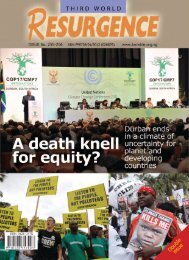Plantations, poverty and power - Critical Information Collective
Plantations, poverty and power - Critical Information Collective
Plantations, poverty and power - Critical Information Collective
You also want an ePaper? Increase the reach of your titles
YUMPU automatically turns print PDFs into web optimized ePapers that Google loves.
56<br />
to refinance loans that it had failed to repay. When it failed to repay the new loan the company arranged<br />
yet another loan. 277 The Widjaja family has managed to pocket the profits, delay paying its debts, avoided<br />
repossession of its assets, avoided any meaningful restructuring of its corporate empire <strong>and</strong>, so far at<br />
least, Widjaja family members have avoided going to jail.<br />
CIFOR’s researchers point out that APP’s financial collapse had little to do with the Asian economic<br />
crisis, which happened four years before APP defaulted on its debts. When the exchange rate of the<br />
rupiah collapsed against the dollar, this was to some extent to APP’s advantage – production costs were in<br />
rupiah <strong>and</strong> export oriented sales were mainly in dollars. CIFOR’s report explains that the losses were<br />
related<br />
“to the global oversupply of pulp <strong>and</strong> paper products on the international market, an increase in<br />
production costs (for unclear reasons), losses due to foreign exchange rates (registered in the financial<br />
reports but not always realized), <strong>and</strong> other unspecified reasons (the financial reports specify ‘other costs’<br />
without being any more precise).” 278<br />
Environmental destruction <strong>and</strong> violence<br />
The worst aspect of APP’s operations, however, is not the fact that the company has managed to obtain<br />
large amounts of money which it will not, <strong>and</strong> probably cannot, repay. The company has devastated the<br />
environment <strong>and</strong> livelihoods of thous<strong>and</strong>s of people in Sumatra.<br />
When Nordea provided a loan to Arara Abadi, APP’s plantation company, the bank provided no<br />
environmental or social dem<strong>and</strong>s on the company as part of the deal. 279 It would be unfair, however, to<br />
single out Nordea. The bank is just one of APP’s many financiers that failed to carry out adequate due<br />
diligence before giving loans to APP. Having h<strong>and</strong>ed over the cash, none of the banks has made serious<br />
attempts to limit the social <strong>and</strong> environmental damage carried out by APP or its subsidiaries.<br />
Large areas of Indah Kiat’s concessions in Riau are on the l<strong>and</strong> of the indigenous Sakai people, who were<br />
evicted to make way for the pulpwood operations. 280 In 2001, villagers won the l<strong>and</strong> rights to 70,000<br />
hectares of APP’s concession. APP lost one quarter of its concession area. A report produced in 2001 by<br />
consulting firm AMEC notes that “The existing level of claim disputes can have a large impact on<br />
sustainable wood supply plans. If the number of successful claims escalates, it will have a further severe<br />
impact”. 281<br />
277 For a dizzying overview of the loans that Indah Kiat managed to secure, see Ed Matthew <strong>and</strong> Jan Willem van Gelder<br />
(2001) “Paper Tiger, Hidden Dragons. The responsibility of international financial institutions for Indonesian forest<br />
destruction, social conflict <strong>and</strong> the financial crisis of Asia Pulp & Paper”, Friends of the Earth - Engl<strong>and</strong>, Wales &<br />
Northern Irel<strong>and</strong>, May 2001, pages 29-31.<br />
278 Romain Pirard <strong>and</strong> Rofikoh Rokhim (2006) “Asia Pulp & Paper Indonesia: The business rationale that led to forest<br />
degradation <strong>and</strong> financial collapse ”, CIFOR, Working Paper No. 33, page 11.<br />
http://www.robinwood.de/german/trowa/sumatra/appcifor2006.pdf<br />
279 Mats Valentin <strong>and</strong> Kristina Bjurling (2004) “Swedish involvement in the Indonesian paper <strong>and</strong> pulp industry”,<br />
SwedWatch, October 2004, page 12.<br />
280 Ricardo Carrere <strong>and</strong> Larry Lohman (1996) Pulping the South Industrial Tree <strong>Plantations</strong> <strong>and</strong> the World Paper<br />
Economy, Zed Books, page 222.<br />
281 Christopher Barr (2004) “Risk Analysis <strong>and</strong> Impact Assessment for Pulp <strong>and</strong> Plantation Investments: The Case of<br />
Indonesia”, presentation at International Forum on Finance <strong>and</strong> Investment in China’s Forestry Sector, Center for<br />
International Forestry Research (CIFOR), Beijing, 22-23 September 2004.















